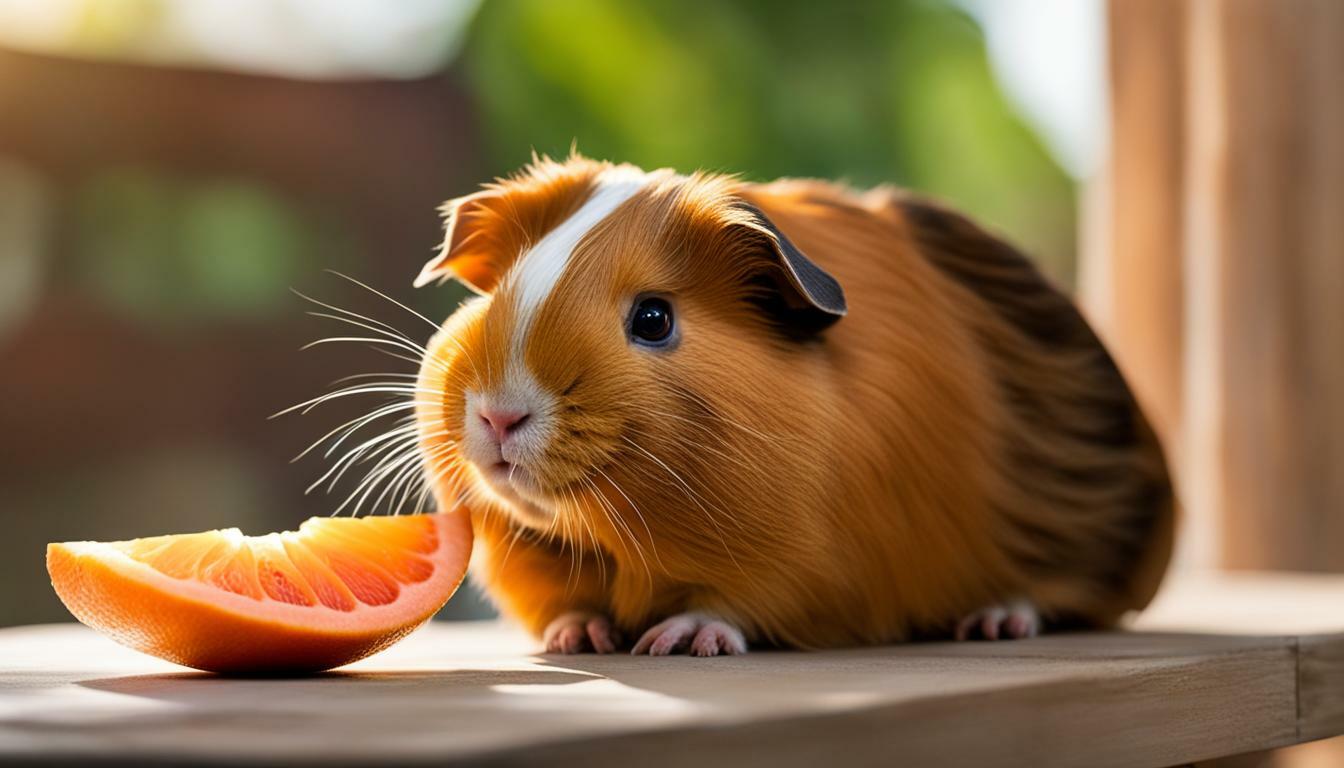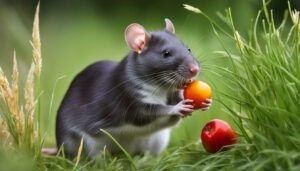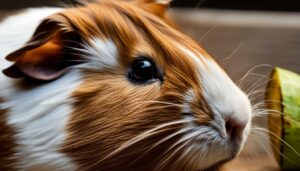If you’re wondering whether guinea pigs can enjoy the tangy goodness of grapefruit, you’ve come to the right place!
Key Takeaways:
- Guinea pigs can eat grapefruit, but it should only be served as an occasional treat.
- Grapefruit can help prevent scurvy, aid digestion, and provide antioxidants for guinea pigs.
- Too much grapefruit can lead to health issues such as high blood pressure, obesity, mouth burning, and urinary tract infections.
- It is recommended to feed guinea pigs a small piece of grapefruit once or twice a week, mixed with other fresh fruits and vegetables for added nutrition.
- Grapefruit rinds are safe for guinea pigs to eat, but should be cut into small pieces first.
- Other safe fruits for guinea pigs include apples, bananas, kiwi, and watermelon.
- Fruits should be fed in moderation to avoid health problems.
Guinea Pig Diet and Nutrition
Before we delve into the specifics of grapefruit for guinea pigs, let’s first understand the basics of their diet and nutritional needs. Guinea pigs are herbivores, meaning their diet consists mainly of plant-based foods. It is crucial to provide them with a balanced and nutritious meal plan to ensure their overall health and well-being.
Here are some important points to consider when it comes to guinea pig diet:
- Variety: Guinea pigs thrive on a diverse diet. It is essential to offer them a wide range of fresh fruits and vegetables to meet their nutritional requirements.
- Hay: Timothy hay should make up the bulk of a guinea pig’s diet. It provides essential fiber for proper digestion and helps wear down their constantly growing teeth.
- Pellets: Guinea pig pellets should be high quality and specifically formulated for their nutritional needs. They contain important vitamins and minerals that may be lacking in their diet.
- Vegetables: Dark leafy greens like kale, spinach, and romaine lettuce should be included in their daily meals. Other safe options include bell peppers, carrots, and cucumbers.
Feeding your guinea pig a balanced and varied diet is crucial for their overall health. However, it is important to remember that not all foods are safe for them to consume. Avoid feeding them foods that are toxic to guinea pigs, such as chocolate, onions, and garlic.
| Safe Foods for Guinea Pigs | Avoid |
|---|---|
| Timothy hay | Chocolate |
| Fresh fruits (in moderation) | Onions |
| Vegetables | Garlic |
| Pellets |
Remember to always introduce new foods gradually and monitor your guinea pig for any adverse reactions. If you have any concerns about their diet or nutrition, consult with a veterinarian who specializes in small animals.
Grapefruit as a Dietary Option for Guinea Pigs
Now, let’s explore whether grapefruit can be a part of your guinea pig’s menu and how it can contribute to their well-being. Guinea pigs are herbivores and require a diet rich in fiber, vitamins, and minerals to maintain their overall health. While fresh fruits are an important part of their diet, not all fruits are safe for guinea pigs to consume.
Grapefruit, with its tangy flavor and juicy texture, can be included in your guinea pig’s diet in moderation. It provides several nutritional benefits, including being a great source of calcium, fiber, and vitamins A, E, and C. These vitamins are essential for strengthening the immune system, promoting healthy skin and fur, and maintaining good eyesight.
However, it’s important to note that grapefruit should only be served as an occasional treat due to its high sugar content and acidity. Too much grapefruit can lead to health issues such as high blood pressure, obesity, mouth burning, and urinary tract infections. To prevent these problems, it is recommended to feed your guinea pig a small piece of grapefruit once or twice a week, and to mix it with other fresh fruits and vegetables for added nutrition.
| Nutritional Value of Grapefruit | Per 100g |
|---|---|
| Calories | 42 |
| Calcium | 12mg |
| Fiber | 1.6g |
| Vitamin A | 61µg |
| Vitamin E | 0.13mg |
| Vitamin C | 31.2mg |
In addition to the flesh of the grapefruit, guinea pigs can also safely eat the rind. However, it’s important to cut it into small pieces to prevent any choking hazards. If your guinea pig shows signs of discomfort or digestive issues after consuming grapefruit, it’s best to consult a veterinarian.
Remember, while grapefruit can be a tasty and nutritious addition to your guinea pig’s diet, it should always be fed in moderation. This will ensure they receive a balanced meal plan that meets their specific nutritional needs. Other safe fruits for guinea pigs include apples, bananas, kiwi, and watermelon. Introducing a variety of fruits can provide your furry friend with different flavors and nutrients, keeping their diet interesting and nutritious.
Nutritional Value of Grapefruit for Guinea Pigs
Grapefruit is packed with various nutrients that can offer significant value to your guinea pig’s diet. It is a rich source of vitamin C, which is crucial for their overall health and immune system. This vitamin helps in collagen production, aids in wound healing, and improves the absorption of iron from plant-based foods. Additionally, grapefruit contains essential vitamins like A and E, which promote healthy skin, coat, and eyesight. These vitamins also act as antioxidants, protecting cells from damage caused by free radicals.
Furthermore, grapefruit is a good source of fiber and can contribute to a healthy digestive system in guinea pigs. Fiber promotes regular bowel movements, prevents constipation, and aids in proper digestion. It also helps to maintain a healthy weight and prevent obesity in your furry friend.
While grapefruit is a nutritious option, it should only be offered as an occasional treat. The high sugar content and acidity of grapefruit can lead to health issues if fed in excess. It is advisable to serve your guinea pig a small piece of grapefruit once or twice a week, alongside a balanced diet of fresh fruits, vegetables, and hay. Remember to cut the grapefruit into small pieces to prevent choking hazards. It is also essential to introduce new foods gradually to prevent any digestive upsets.
| Nutrient | Amount per 100g |
|---|---|
| Calories | 41 |
| Carbohydrates | 10.7g |
| Fiber | 1.6g |
| Protein | 0.8g |
| Fat | 0.1g |
| Vitamin C | 31.2mg |
| Vitamin A | 19IU |
| Vitamin E | 0.13mg |
| Calcium | 12mg |
Note: The values mentioned in the table are approximate and may vary based on the size and variety of the grapefruit.
In conclusion, grapefruit can be a healthy addition to your guinea pig’s diet when offered in moderation. It provides essential vitamins, fiber, and antioxidants that can support their overall well-being. However, it is crucial to balance their diet with other safe fruits, vegetables, and hay to ensure they receive a diverse range of nutrients. Always consult with a veterinarian if you have any concerns about your guinea pig’s diet or health.
Potential Health Benefits of Grapefruit for Guinea Pigs
Including grapefruit in your guinea pig’s diet can bring about several potential health advantages. Grapefruit is a nutritious fruit that is rich in vitamins and minerals, making it a beneficial addition to your pet’s meal plan. This tangy citrus fruit is an excellent source of vitamin C, which is essential for guinea pigs as they cannot produce this vitamin on their own. Vitamin C plays a crucial role in boosting their immune system, promoting healthy skin and fur, and supporting overall good health.
Grapefruit also contains antioxidants, such as flavonoids and limonoids, which can help protect your guinea pig’s cells from damage caused by harmful free radicals. These antioxidants have anti-inflammatory properties and may contribute to reducing the risk of certain diseases in guinea pigs.
In addition, grapefruit can aid digestion in guinea pigs due to its fiber content. Fiber is vital for maintaining a healthy digestive system and preventing issues like constipation. Including grapefruit in your guinea pig’s diet can help regulate their bowel movements and promote optimal gastrointestinal health.
| Key Nutritional Benefits of Grapefruit for Guinea Pigs |
|---|
| High in vitamin C, supporting immune function |
| Contains antioxidants to help protect cells |
| Aids digestion due to its fiber content |
However, it is important to note that grapefruit should be fed to guinea pigs in moderation. While it offers potential health benefits, consuming too much grapefruit can lead to health issues such as high blood pressure, obesity, mouth burning, and urinary tract infections. To ensure a balanced diet for your guinea pig, it is recommended to feed them a small piece of grapefruit once or twice a week, alongside a variety of other fresh fruits and vegetables.
When serving grapefruit to your guinea pig, ensure that the fruit is thoroughly washed, and any seeds or pith are removed. Grapefruit rinds are safe for guinea pigs to eat, but should be cut into small, manageable pieces. Remember to monitor your guinea pig’s response to grapefruit and make any necessary adjustments to their diet based on their individual needs and preferences.
In addition to grapefruit, there are other safe fruits that guinea pigs can enjoy, such as apples, bananas, kiwi, and watermelon. However, it is important to feed fruits in moderation to avoid overconsumption of sugars and maintain a balanced diet for your furry friend.
Cautionary Considerations when Feeding Grapefruit to Guinea Pigs
While grapefruit can be a nutritious addition to your guinea pig’s diet, it’s essential to exercise caution to ensure their well-being. Due to its high sugar content and acidity, grapefruit should only be served as an occasional treat. Feeding your guinea pig too much grapefruit can lead to health issues such as high blood pressure, obesity, mouth burning, and urinary tract infections.
It is recommended to feed your guinea pig a small piece of grapefruit once or twice a week, and to mix it with other fresh fruits and vegetables for added nutrition. This will help prevent overconsumption and maintain a balanced diet. When offering grapefruit to your guinea pig, always remember to wash it thoroughly, remove any seeds, and cut it into small, bite-sized pieces to make it easier for them to eat.
Table: Safe Fruits for Guinea Pigs
| Fruit | Preparation | Serving Frequency |
|---|---|---|
| Grapefruit | Wash, remove seeds, and cut into small pieces | Once or twice a week |
| Apple | Wash, remove core, and cut into small pieces | A few times a week |
| Banana | Peel and cut into small slices | A few times a week |
| Kiwi | Peel and cut into small pieces | A few times a week |
| Watermelon | Remove seeds and cut into small pieces | A few times a week |
Remember, moderation is key when introducing any new food to your guinea pig’s diet. It is important to observe their reaction and monitor their overall health. If you notice any unusual behavior or digestive issues after feeding your guinea pig grapefruit or any other fruit, it is recommended to consult with a veterinarian for further guidance.
Recommended Feeding Guidelines for Grapefruit
To ensure optimal health, it is crucial to know the recommended feeding guidelines for grapefruit and how to incorporate it into your guinea pig’s diet. While grapefruit can provide some nutritional benefits, it should only be given as an occasional treat due to its high sugar content and acidity.
Giving your guinea pig a small piece of grapefruit once or twice a week is sufficient. It is important to remember that moderation is key. Too much grapefruit can lead to health issues such as high blood pressure, obesity, mouth burning, and even urinary tract infections.
When feeding grapefruit to your guinea pig, make sure to remove any seeds or pits, as they can pose a choking hazard. It is also best to cut the grapefruit into small, bite-sized pieces to make it easier for your furry friend to consume.
| Fruits Safe for Guinea Pigs | Frequency of Feeding |
|---|---|
| Grapefruit | Once or twice a week |
| Apples | 2-3 times a week |
| Bananas | 2-3 times a week |
| Kiwi | Once a week |
| Watermelon | Once a week |
It is also important to provide a varied diet for your guinea pig. Along with grapefruit, you can offer other safe fruits such as apples, bananas, kiwi, and watermelon. These fruits should also be given in moderation to prevent any potential health problems. Remember to always introduce new foods gradually and monitor your guinea pig’s reaction to ensure they tolerate them well.
Additionally, make sure to complement your guinea pig’s diet with fresh vegetables, hay, and high-quality guinea pig pellets. This will ensure that they receive a well-rounded and balanced meal plan that meets their nutritional needs.
Other Safe Fruits for Guinea Pigs
While grapefruit can be enjoyed on occasion, there are other safe and delicious fruits that you can offer to your furry friend. These fruits provide a variety of flavors and essential nutrients to keep your guinea pig healthy and happy. Here are some popular options:
- Apples: Apples are a crisp and refreshing fruit that guinea pigs love. They are rich in vitamin C and fiber, making them a great choice for their overall health.
- Bananas: Bananas are a favorite among guinea pigs due to their sweet taste and soft texture. They are packed with potassium and vitamin B6, which are essential for their wellbeing.
- Kiwi: Kiwi is a tropical fruit that guinea pigs can enjoy in moderation. It is high in vitamin C, vitamin K, and fiber, which promotes a healthy immune system and aids in digestion.
- Watermelon: Watermelon is a hydrating and refreshing fruit for guinea pigs, especially during hot summer months. It is low in calories and high in vitamins A and C, promoting good eye health and boosting their immune system.
Remember, it is important to introduce new fruits gradually to your guinea pig’s diet and observe their reaction. Start with small amounts and monitor for any signs of stomach upset or allergies. Always wash fruits thoroughly and remove any seeds or pits before offering them to your guinea pig.
| Fruit | Vitamin C (mg per 100g) | Fiber (g per 100g) | Other Key Nutrients |
|---|---|---|---|
| Apple | 0.5 | 2.4 | Potassium, Vitamin A |
| Banana | 8.7 | 2.6 | Potassium, Vitamin B6 |
| Kiwi | 92.7 | 3 | Vitamin K, Fiber |
| Watermelon | 8.1 | 0.4 | Vitamin A, Vitamin C |
As with all treats, moderation is key when feeding fruits to your guinea pig. Fruits should only make up a small portion of their overall diet, with the majority consisting of fresh hay, vegetables, and a high-quality pellet food. Remember to consult with your veterinarian for specific dietary recommendations and guidelines based on your guinea pig’s individual needs.
Moderation is Key
As with any food, it’s crucial to regulate the amount of grapefruit and other fruits you provide to your guinea pig. While grapefruit can offer some health benefits and nutritional value, overfeeding can lead to various health issues. Guinea pigs have sensitive digestive systems, and excessive intake of sugary fruits like grapefruit can cause obesity, high blood pressure, and even urinary tract infections.
It is recommended to offer your guinea pig a small piece of grapefruit once or twice a week as a special treat. Make sure to remove any seeds and cut the fruit into small, manageable pieces. Mixing grapefruit with other fresh fruits and vegetables can provide a balanced diet for your furry friend, ensuring they get a variety of nutrients.
Grapefruit rinds are also safe for guinea pigs to eat, but they should be cut into small, bite-sized pieces to prevent choking hazards. However, it’s important to note that some guinea pigs may have a natural aversion to the strong smell and taste of grapefruit. If your pet shows disinterest or refuses to eat grapefruit, it’s best to respect their preferences and focus on other safe fruits like apples, bananas, kiwi, and watermelon.
| Safe Fruits for Guinea Pigs | Frequency of Feeding |
|---|---|
| Grapefruit | Once or twice a week |
| Apples | Every other day |
| Bananas | Once a week |
| Kiwi | Once a week |
| Watermelon | Once or twice a week |
Remember, moderation is key when it comes to incorporating fruits into your guinea pig’s diet. Always monitor your pet’s health and consult a veterinarian if you have any concerns or questions about their diet or overall well-being.
Conclusion
In conclusion, grapefruit can be included in your guinea pig’s diet as an occasional treat, but it should be offered in moderation and balanced with other nutritious foods. While grapefruit provides some health benefits, such as preventing scurvy, aiding digestion, and offering antioxidants, it is important to be mindful of its high sugar content and acidity.
Grapefruit should be given to your guinea pig only once or twice a week, in small pieces. It is also advisable to mix it with other fresh fruits and vegetables to ensure a well-rounded nutritional intake for your pet. Remember that variety is key in providing a balanced diet for guinea pigs, so offering different fruits and vegetables in addition to grapefruit is essential.
When feeding grapefruit, it is crucial to remove any seeds and cut the fruit into small, easily manageable pieces. This will help prevent choking hazards and ensure your guinea pig can enjoy the treat safely. Additionally, grapefruit rinds can also be given to guinea pigs, but they should be cut into small pieces to avoid any potential digestive issues.
While grapefruit can be a tasty and healthy addition to your guinea pig’s diet, it is important to exercise caution and monitor their intake. Too much grapefruit can lead to health issues, including high blood pressure, obesity, mouth burning, and urinary tract infections. Therefore, always remember to feed fruits in moderation and consult your veterinarian if you have any concerns about your guinea pig’s diet or health.
FAQ
Can guinea pigs eat grapefruit?
Yes, guinea pigs can eat grapefruit, but it should only be served as an occasional treat due to its high sugar content and acidity.
What are the nutritional benefits of grapefruit for guinea pigs?
Grapefruit is a good source of calcium, fiber, and vitamins A, E, and C, which can help prevent scurvy, aid digestion, and provide antioxidants for guinea pigs.
Can grapefruit be harmful to guinea pigs?
While grapefruit can offer health benefits, too much can lead to issues such as high blood pressure, obesity, mouth burning, and urinary tract infections.
How often should I feed my guinea pig grapefruit?
It is recommended to feed guinea pigs a small piece of grapefruit once or twice a week, and to mix it with other fresh fruits and vegetables for added nutrition.
Can guinea pigs eat grapefruit rinds?
Yes, grapefruit rinds are safe for guinea pigs to eat, but they should be cut into small pieces first.
Are there other fruits that guinea pigs can eat?
Yes, guinea pigs can also eat apples, bananas, kiwi, and watermelon, among other fruits. However, fruits should be fed in moderation to avoid health problems.




